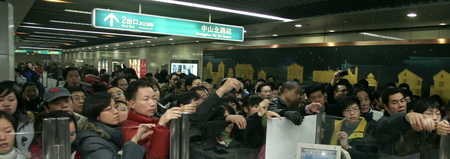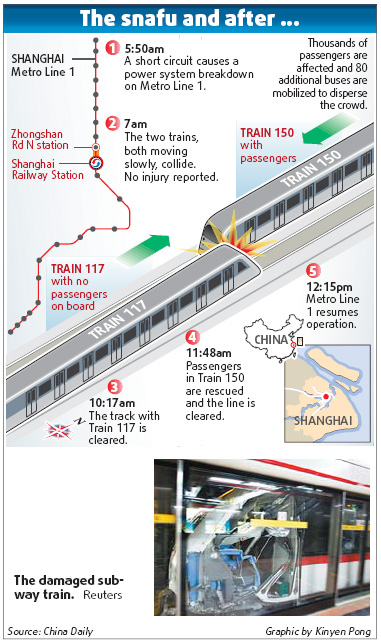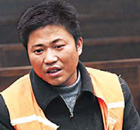Top Biz News
Subway snag hits thousands
By Gao Changxin and Yu Ran (China Daily)
Updated: 2009-12-23 07:52
 |
Large Medium Small |
 |
|
Passengers throng to claim refunds after a system failure halted a subway line in Shanghai and caused two trains to collide yesterday morning. [China Daily] |
Service on the busy Line 1 was disrupted due to an electrical failure, which reportedly triggered the collision in the tunnel a little after seven in the morning. Nobody was hurt in the accident and service resumed around 12:15 pm, according to a Xinhua report.
One frequent commuter on Line 1, Tony Zhang, said he and other co-passengers were trapped for "hours" in the stuffy underground before rescue workers started guiding them back to the end of the line from around 9:30 in the morning.
"We were frightened and confused," Zhang recalled, complaining that the passengers were left in the dark and provided with little information about their condition. "There was no announcement - nothing - until someone finally came to tell us to evacuate from the other end of the train," he fumed.
"The experience was horrible; I will surely ask for compensation," he said.
For 25-year-old Zhang, the ordeal began at 6:30 am, when he, as usual, got on the tube at Peng Pu New Village station to reach his workplace, a State-run steel factory.
At 7:10 am the train "stopped suddenly and then we felt that it had leaned to the right for a bit. I heard loud screams and many of us almost fell. I felt extremely panicky," Zhang recalled.
After that, until 9:30 am, Zhang and others on the train were stuck, waiting to be rescued.
"We became calm after the accident, but turned panicky soon because two hours had elapsed and there was no word on the subway broadcast system about what had happened.
"Though the lights were still on and the air-conditioning system seemed to be working, many of us felt very hot and stuffy. Some opened the windows and doors manually for fresh air.
"The only thing we could do was discuss what had happened and why it was taking so long for help to arrive."
Elsewhere in the city, the peak-hour accident meant long lines of passengers waited in bus stops during the morning rush. At the Shanghai Railway Station, the queue stretched for over 50 m. Frustrated commuters had trouble finding taxis trapped in the city's traffic jams.
"I found out that the entrance to Metro Line 1 was blocked and so I thought of taking a bus through a different route, but I failed to get on to the bus as it was jammed with people," complained Li Bingqing, a journalist who left for work at 10 am. "The roads were totally blocked and I had to walk for over half an hour to get on to a taxi. It took me nearly two hours to reach my workplace, instead of half-an-hour normally."
Stuck underground, Zhang recalled: "Most of us were on our way to work, so we were just worried about being late for work. But, there was a group of middle-aged citizens who had set aside the day for tomb sweeping. They started complaining and said they would definitely seek compensation from the operators."
Indeed, most passengers who were trapped underground got a letter of apology from the Metro operator. The operator also said the ticket cost would be reimbursed, without specifying how exactly it would be done.
Hours later, Sun Jianping, the head of the Shanghai Municipal Transport and Port Authority, told the media that officials were investigating the cause of the incident "in order to make sure the subway network in Shanghai operates safely in the future."
Although this was the worst accident in Shanghai Metro's history, it was not the first time that the city's subway service had been disrupted this year.
Twice before, on March 2 and July 15, the subway system's Line 2 which tunnels across Huangpu River, went down. Regular service on Line Nine was disrupted on August 19.
On Aug 25, which Shanghai commuters call the Black Tuesday, four subway lines broke down in less than 60 minutes during peak hour that morning.
Zhang, of course, was traveling yesterday on Line 1, which runs through the major commercial hubs of Xujiahui and Huaihai Road, and is the busiest among the city's nine subway lines.
"I overheard someone say that an old couple had fainted in another carriage. I saw a migrant couple jump out of the train carrying a kid. They said they had to reach the hospital immediately because the child was scheduled to undergo an operation," he recalled,
Between 9:30 and 10:30 am, rescue personnel arrived to guide the passengers out of the tunnel, he said. "Finally, around 10 safety personnel came over to help us. They asked us to walk back to the end of the tube where another train was waiting to transfer us back to North Zhongshan Road Station."
"It took us over half an hour to do so because there were too many people on the train."
At 10:50 am, most of the trapped passengers were on the rescue train.
"On my way out, I saw hundreds of emotional passengers gathered outside the ticket office shouting for compensation. The exit was crowded. I had to walk a few blocks to get a taxi," Zhang said.
"The subway in Shanghai has seen rapid development this year with many new lines being put into operation. I think it's normal to see some problems pop up," said Xie Weida, the director of the Tongji University Institute of Railway & Urban Rail Transit.
Passengers also use a variety of different lines, which compound the problem. This, said Xie, "requires a lot of coordination and practice to make it run smoothly."















